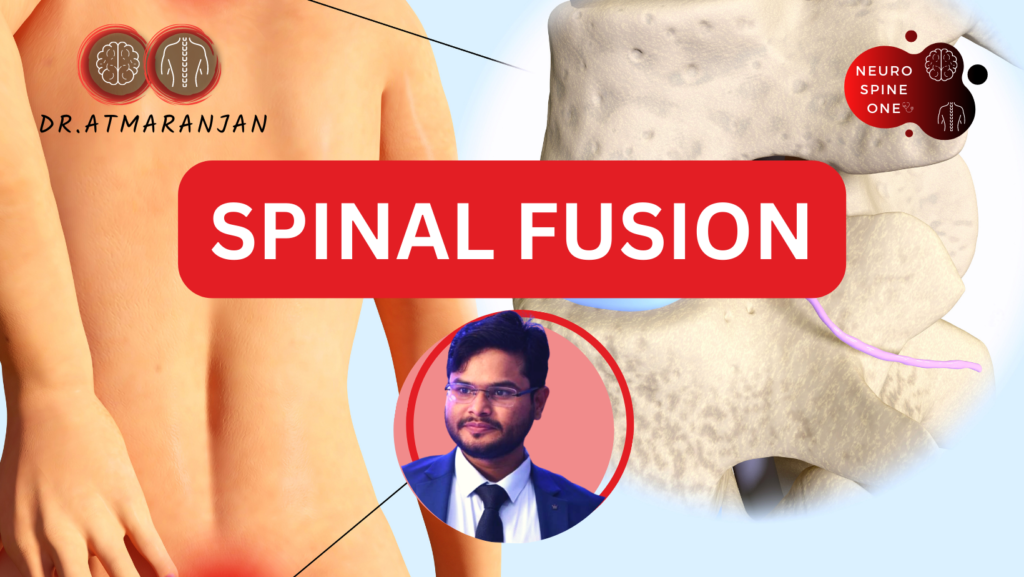
Spinal Fusion
Spinal fusion is a surgical procedure that joins two or more vertebrae together in order to stabilize the spine and eliminate pain. The procedure is typically used to treat conditions such as degenerative disc disease, spondylolisthesis, and scoliosis.
Degenerative disc disease (DDD)
Degenerative disc disease (DDD) is a condition that occurs when the intervertebral discs, which are the cushions between the vertebrae in the spine, deteriorate and lose their ability to absorb shock and support the spine. This can cause the discs to become thinner, leading to a loss of height and increased pressure on the spinal cord or nerve roots. DDD is most common in the cervical and lumbar regions of the spine, and it is a natural part of the aging process.
Symptoms of DDD can include low back pain, neck pain, stiffness, numbness, tingling, or weakness in the limbs. These symptoms can be caused by the wear and tear on the disc itself, or by bone spurs that may form as the body tries to stabilize the spine.
Treatment options for DDD include conservative measures such as physical therapy, pain management, and medications, as well as more invasive options such as spinal fusion surgery. In some cases, surgery may be recommended if non-surgical treatments are not effective in relieving pain or if the condition is causing nerve damage. It’s important to work closely with your doctor to find the best treatment plan for you.
Spondylolisthesis
Spondylolisthesis is a condition where one vertebra in the spine slips out of place onto the vertebra below it. This can occur as a result of a congenital defect, a stress fracture, or a degenerative condition such as degenerative disc disease. The most common location for spondylolisthesis to occur is in the lumbar (lower) spine, but it can also occur in the cervical (neck) and thoracic (upper back) regions of the spine.
Symptoms of spondylolisthesis can include low back pain, muscle spasms, stiffness, and numbness or weakness in the legs. In some cases, the slipped vertebra can put pressure on the spinal cord or nerve roots, causing more severe symptoms such as bowel or bladder dysfunction.
Treatment for spondylolisthesis will depend on the severity of the condition and the symptoms experienced by the patient. Conservative measures such as physical therapy, pain management, and medications can help alleviate symptoms. For more severe cases, surgery such as spinal fusion may be recommended to stabilize the spine and prevent further slippage. It’s important to work closely with your doctor to find the best treatment plan for you.
Scoliosis
Scoliosis is a condition in which the spine has an abnormal curvature to the side. The curvature can take the form of a “C” or “S” shape, and it can occur in the thoracic, lumbar or thoracolumbar regions of the spine. There are several types of scoliosis, the most common being idiopathic scoliosis, which is scoliosis of unknown cause. Other types of scoliosis include congenital scoliosis, which is present at birth, and neuromuscular scoliosis, which is caused by a neurological condition such as cerebral palsy or muscular dystrophy.
Symptoms of scoliosis can include uneven shoulders, a protruding shoulder blade, a tilted pelvis, and a visibly curved spine. In some cases, scoliosis can also cause pain, fatigue, and difficulty breathing.
Treatment options for scoliosis depend on the degree of curvature and the patient’s age and level of activity. For mild cases of scoliosis, observation and regular monitoring may be recommended. For more severe cases, treatment may include a brace to hold the spine in a corrected position or surgery to correct the curvature and stabilize the spine. Scoliosis surgery can include spinal fusion, which involves joining two or more vertebrae together to stabilize the spine, and instrumentation, which involves using metal rods, screws, or hooks to hold the spine in a corrected position.
It’s important to work closely with your doctor to find the best treatment plan for you.
Spinal Fusion Surgery Procedure’s
The surgery involves removing the damaged disc or disc material and then inserting a bone graft between the vertebrae. The bone graft can come from the patient’s own body (autograft) or from a bone bank (allograft). The vertebrae are then held together with metal rods, screws, and/or cages to allow the bone graft to fuse the vertebrae together over time.
Recovery time
Recovery time for spinal fusion can vary depending on the patient and the extent of the surgery. It typically takes several months for the bone graft to fuse the vertebrae together and for the patient to fully heal. Physical therapy is often recommended to help the patient regain strength and mobility.
Spinal fusion may be a complex surgery and it’s important to discuss the risks and benefits of the procedure with Dr Atmaranjan Dash who is an expert in Spinal Fusion Surgery in Bhubaneswar, Odisha, India.
